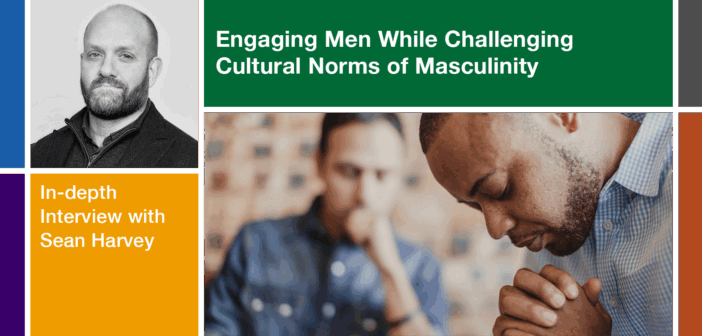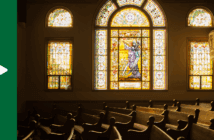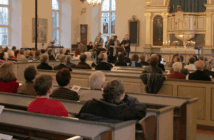How can congregations engage men in ways that challenge cultural norms of masculinity? Sean Harvey’s journey began with a transformative experience at work, where he was encouraged to lead from his heart. This catalyzed his mission to support men in healing and rediscovering purpose through the Warrior Compassion Institute. He empowers faith communities to engage men by fostering spaces of vulnerability, curiosity, and connection—meeting men where they are, while challenging cultural norms of masculinity with compassion and creativity.
Watch the interview video, listen to the interview, or continue reading.
Jessica Anschutz: Sean, your work seeks to help men facing challenges of identity, purpose, and connection. What inspired you to get involved in this work?
Sean Harvey: I think it all started when I left consulting on Wall Street and an opportunity came along within two weeks of leaving my former position at Eileen Fisher, the women’s fashion company. After going through an eight-month interview process, on my first day my two bosses sat me down and said, “So Sean, we just want to acknowledge that you have proven yourself in the interview process. We now want you to stop proving yourself and learn how to be who you are. When we interviewed you, you showed us your heart, and you showed us your polish. We hired you for your heart, and we want to see less of your polish.” And I think that was one of those pivotal moments and permission to start on the journey of going inward.
During my time at Eileen Fisher, I noticed other men were having similar experiences. And remember, Eileen Fisher is 83% women, so I was talking to the 17% of men in the company, and they would say something like, “You know, my wife said …” or “my girlfriend said …” And it usually went something like, “My wife said I listen differently. I’m more patient. I have more access to my emotions. I’m more creative. I’m able to solve problems differently because of this environment. I stopped needing to be right all the time, and I started to be more curious. I started to have more patience with the unknown or with the gray. Didn’t have to be so concrete.” But what’s common with every man that I talked to was they would say they felt more comfortable in their own skin. And I said, “You know what? We have to bottle this up and take it out to more than the 200 men that are in this company.” That’s really where it started.
Jessica Anschutz: Great. So, share with our listeners about the Warrior Compassion Institute.
Sean Harvey: Warrior Compassion Institute is really focused on helping to disrupt the quiet crisis of men; what I like to call “warrior cultures” or “male dominated cultures.” So, police, military defense, government, finance, tech, energy, etc. It asks how we can create men’s healing and transformation in these organizations. When I was at Eileen Fisher, I was the Head of Personal Transformation and Wellbeing for the company. So, I had exposure and experience with creating systems-level personal transformation experiences that are scalable. I noticed that once they got a taste of it, men would say, “I want more of this.”
Jessica Anschutz: Why do you find men are looking for that community and connection?
Sean Harvey: I think we’re seeing an epidemic of isolation and loneliness, and I think isolation is sort of a breeding ground for many maladaptive behaviors, including movements to radicalization or extremism. It’s not that men often seek this out consciously; but I think there’s something within them that’s yearning. So even if they can’t articulate or have the words for it, there’s still something that’s missing. And often that thing that is missing is a deeper sense of connection, a deeper sense of belonging and acceptance. It’s often spoken of in many ways, but at the end of the day I think it comes down to a human need—our need or desire, our yearning for some deeper connection. And I think, especially in the era of social media, I think we’ve been operating in this place of faux-intimacy; you know, this level of connection that doesn’t meet those needs. And as a result, we seek something deeper.
Jessica Anschutz: I am really impressed with your work and your passion for it. I truly think it is your vocational calling. As we think about faith communities, and the ways in which they are engaging men, what words of advice do you have to help them meet these yearnings?
Sean Harvey: I think the first thing that comes to mind is ask. Look at what’s been working and what hasn’t worked. What’s created engagement and what hasn’t? What’s created more of a sense of belonging, and is that really creating the type of engagement around community, around spiritual formation, spiritual community, and connection, and is it really deepening soul-connection? That, I think, is really the deeper yearning. I often say, “Our soul is speaking in ways that our minds can’t hear, but it’s still calling us into those places.” So, one is to ask. Two is to get creative and think about it from a man’s perspective. What are going to be the types of experiences that fit into their lives? When we do soul adventures, it’s a two-to-three-hour experience. It’s not a weekend retreat. Those are important as well, but what fits into your life that has consistency—that has an opportunity that you can see men over time and build those relationships organically.
When I started Men’s Soul Adventures, I started it in Washington, D.C., and I just put it out on Meetup. I didn’t know how many people would come. I didn’t know if it was going to take off. 52 men signed up in the first 24 hours. Within three to four months, we had about 180 men. I went to four other cities, and within three days, we went from 180 to 330 men. And then I got smart, and I started asking, “So why a soul adventure?” And it really broke down into thirds. A third of men said they just wanted a different type of adventure, and it sounded cool. A third said that they just wanted deeper connections with other men. And in writing my book, one of the things that I found was that one of the greatest fears for men is to be vulnerable in front of other men; so, to be able to have those deeper connections. And a third, they just had practical questions around spirituality that they wanted a place to ask. So, I started coining the term, “practical spirituality for dudes.” Just make it accessible, you know? Don’t make it overbearing with dogma, but provide a natural invitation to say, “let me look at myself in a deeper way. Let me look at myself in ways that, you know, see beneath the ego. Help me discover my own truth between and beneath the protective layers and let other men see that real connection and deeper connection is possible.”
Jessica Anschutz: That’s great advice. As you think about your work with men, if a congregation were going to start a men’s ministry, what are some of the key themes that you would want them to keep in mind?
Sean Harvey: First, I would really look at and be honest about the state of men today. Look at the data; look at the research around “What is the state of men?” In one of the statistics I saw, men have declined in faith communities by about 20%. So, you should get curious about what that means. I’ve helped faith communities on their strategic plans and their visions, and as part of that, when we look at congregant engagement, it’s easy to look at the masses and not necessarily look at what is engaging or disengaging men. So, I would say, one: look at the data.
Two: If you’re forming a men’s ministry, let the men tell you what they want. Engage in a conversation with them. Often when I go into an organization, I start by just having a ‘fireside chat’ with the men and seeing what starts to rumble under the surface of what men want to talk about, of what want men want to explore, and what questions they have around faith. Often, the answer is that they have questions around faith, as it relates to modern day living—what is applicable to today, and where they can see themselves in it? I think also that there’s an aspect of, “Let’s be honest and real about religious trauma,” about what folks might be carrying from the past that they’re ready to let go of. How can the church or the community, faith community, meet those needs for today and take a trauma informed approach to honor where men are? I think the other piece is, whatever you do, create it with consistency so that men have some space, some place for vulnerability, for community, and for ongoing conversations.
Jessica Anschutz: Thank you for those insights in engaging men and building men’s ministries. When you think about your work with the Warrior Compassion Institute, what lessons have you learned now that you wish you knew when you started that may be insightful for churches as they seek to engage men in new ways?
Sean Harvey: You know, it’s something that I’d known, but it was something that really came apparent as a facilitator in this work. One of the best things we can do is become quiet and invisible and hold space, as opposed to being on the stage and being the expert on men. I often say that I’m really holding space for men, and it’s less about what I know and more about the space I can hold for the wisdom that’s already in the room.
I remember someone asked me once, they’re like, “What is your definition of men and what do you tell men?” And I said, “I don’t have one, and I don’t know.” Because I think we all have different experiences. We all have different relationships to our masculine, to our feminine and inner energies. We also have influences from faith traditions that inform how we think about what it means to be a man or not. So, I think the biggest thing we can do, and it’s just been reinforced time and time again, is to be in the inquiry and engagement—in an inquiry as opposed to telling someone what it means to be a man. So many men have different definitions of what it means to be a man, and there’s some commonality. But how have I taken this on for myself? How have I internalized my relationship and this conditioning of what it means to be a man of masculinity.
I think the other part that’s critical is the power of intergenerational connections among men. And one of the things I’ve done in the men’s circles I’ve created is to really have them talk. I had a group where the youngest was 27 and the oldest was like 67, and I had them talk in small groups about their stories and what their mentors taught them about masculinity? What did they learn about masculinity and how has it shifted for them in their lifetime? Now imagine a 27-year-old and a 67-year-old talking about those influences, and what shifted, and that opportunity to say, one: I understand that I’ll never know a 27-year-old’s experience, but I also know I can’t apply what I know around masculinity to you because we have had such different lived experiences. That’s honoring of each other’s experiences. And so, another piece is creating a space for honoring our differences of experiences, as opposed to judging, or wronging, or saying one is better than another.
Jessica Anschutz: I can imagine how powerful the experience is when people are able to share their stories with one another, seeing similarities and differences while also recognizing that each story is valid in its own way. As you think about helping men with their looking at identity and purpose and connection, what are the challenges that you encounter in doing this work?
Sean Harvey: I often say that men will invest in professional development before they invest in personal growth. I think one, we’re operating from a place where there’s stigma, access and availability challenges. I think it’s just in the nature of our conditioning and in even maybe some of our biology. There’s often many more spaces for women to be able to have space to come in and connect with one another, as well as do more of the inner work. For so many men, there’s stigma around this. Will it reflect weakness? Two: can I be vulnerable, and am I willing to be vulnerable? And three: there’s just fewer options for men, and I think there’s fewer options that fit into your life, you know? I often find that spiritual community, faith communities, religious communities have a special place in this because it’s often the place that men feel permission to talk about these things and explore the questions they wouldn’t ask or explore anywhere else.
Just look at 52 men in Washington D.C. coming out in 24 hours. I often don’t think of D.C. as the most explicitly religious or spiritual space. And so again, it’s this speaking to the deeper yearnings. But I think another piece is, how do we, or myself as an interfaith minister, as someone who’s been doing this work for nearly a decade and has been in organizational change for over 25 years, how do we speak to all voices? And how do we speak to folks who are on ideologically different parts of the spectrum and reach them all? As the facilitator, what are my own biases that might be preventing me from seeing everyone in their totality, so they feel like they can come into the space? One of the things I often talk about is this idea of ground neutrality. How do I ground myself in a place of neutrality, so everything is welcome? Not just every person, but every idea and perspective is welcome, and men can trust that the room will honor it without trying to convince or persuade them otherwise. That is, how do I create a neutral space where men can be together and accept that “your truth may not be my truth, but both truths can be true.”
Jessica Anschutz: How have you been able to do that work, to sort of bridge the polarization in groups?
Sean Harvey: First, I often say when I’m training facilitators that we get too consumed by what’s on our PowerPoint deck and with the words we’re using. While I’d say that’s important, I think one thing we don’t talk about enough is our energy and that the room is either with us in the first 30 seconds or not. So, what is the energy we’re bringing in and inviting? Have we cleared ourselves as a vessel for openness in the space?
And so, I think that’s the first. I think the second is, how do you set the container in terms of being energetically invitational, and then how do you create the agreements? So, how are we going to be in this space together. And then, I think it’s important for the facilitator to understand the differences in the space, and to understand their own stuff, so that when the opposing views come into view, you’re able to hold. You as a facilitator can hold both, and it can be your movement from judgment or wronging to pure curiosity.
From that place of what I like to call open-hearted, non-judgmental curiosity, let’s understand what’s there—what’s underneath that. Let’s maybe even call into question some of the reactions or get curious about our own reactions to what we’re hearing. Another piece that I do is a lot of work around separating the humanity of the person, or in this case the man, from the views of the man. I don’t conflate the two. So, how do I love the humanity of the man even if I don’t agree or can’t stand the views? It doesn’t mean that I look at this person differently. I’m still holding them from a place of their humanness and their humanity.
Jessica Anschutz: I appreciate that grounding place for beginning, and I’m grateful for the work that you have done and are doing. Our time is rapidly coming to a close, but I have just a couple more questions. One is how are you engaging more men and new men?
Sean Harvey: I think it’s twofold. One, it’s going to where men are, and it’s also connecting with other communities of men so that it becomes a practice that you’re just surrounded in the work, regardless of if you’re leading it or you’re a participant. So, I guess part of it is that exposure, so that you’re continuing to do your own work. And then two, especially when it comes to this type of soul work and the soul-healing work, I think just start small. I know a colleague, peer friend of mine, he’s created something around walking groups for men. Some have hiking groups. Some have kayaking groups. Some have fishing groups. I think, do what you love and invite other men to come, and then create space for doing something deeper.
If you want to create a men’s ministry within a congregation or a church community, you could do a book club. You could say, “let’s just worship together.” But then also introduce other activities. Men’s lives are busy, and so they may not make space for personal growth or community. And so, the number one thing I would say about creating groups for them is make it interesting. That’s why I like Soul Adventures, because it changes. It’s either a hike or we’re going to go play paintball, or we’re going to go kayaking or rafting. It’s always going to be interesting. Make it varied, so different types of men with different interests can feel themselves connected to it. Also, create whatever you’re doing at various levels of ability, skill, or interest, so that more men have access and can see themselves in it. One thing I often say, you know, is that in this work, there’s those who want to change men because they think there’s something wrong or broken. I think what I’ve found is that the men who are most successful with other men are those who see, believe in, and love other men. Those who want them to be the best versions of themselves, work through what’s holding them back, and unlock their greatest level of compassion—which begins with themselves.
Jessica Anschutz: Sean, as you think about churches and church leaders that are engaged in men’s ministries, what is your hope for congregations in doing this work?
Sean Harvey: One, I hope that churches and congregations can create programs and create experiences that are inviting and enticing to more men. Because I think the biggest thing we’re trying to address (and the simplest thing to address for so many challenges that men face) is breaking men out of isolation and loneliness and getting them into community and connection. If you can create something that is consistent; something that men want to do rather have to do, something out of which they’re getting something for themselves. I hope that churches offer this, and that more men have exposure to this, and that you have facilitators who can really hold space for men. Also, facilitators who have done their work on their own traumas—their own wounds, so they can be not just beacons, but also role models, and can also “get” what men are experiencing. Not theorizing, but really be empathetic and compassionate, you know, and create spaces where men really do hold each other and hold each other up.
Related Resources
- Leading Admist Christian Nationalism by Lovett Weems
- Diverse Congregations are Stronger Congregations by Faith Commuities Today
- 16 Signs Your Church May Need a Renewed Focus on Disciple Making by Mike Shreiner and Ken Willard
If you would like to share this article in your newsletter or other publication, please review our reprint guidelines.




